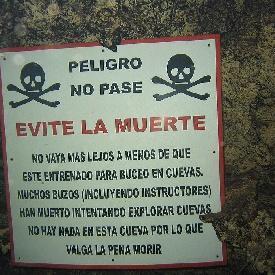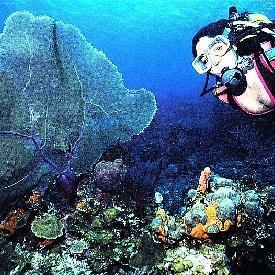Bay of Pigs
Bay of Pigs (Bahía de Cochinos) is the place famous for the unsuccessful attempt of CIA and Cuban exile for the invasion and subsequent removal of Castro’s government in April 1961. It happened in the past; now the event is reminded at the local museum. From the diving point of view, the locality is known particularly for its caves with mixed water (fresh water up and sea water below 10m) and beautiful walls in the sea near the place called Punta Perdis (the local restaurant offers specialities from crocodile meat). Bay of Pigs is a deeply cut bay (approximately 20km), protected from breaker and therefore characteristic with its permanently excellent visibility. Diving is possible there from two bases: Playa Larga and Playa Girón. In view of permanent suitable conditions for diving, it often serves as an alternative destination for diving bases in Varadero where the stormy Atlantic very often makes diving impossible. You may meet there plenty of divers who had intended to dive in Varadero but eventually they arrived in Bay of Pigs. All localities in the area of Bay of Pigs are available from the shore; and the divers can choose between two types of dive. They can dive either in the sea or in caves that are called there cassimbas.
 | Bay of PigsThere are several dozens of flooded caves between Playa Larga and Playa Girón; their discovery, exploration and mapping were hugely participated by three great expeditions of speleologists from Olomouc in the 1990s. They spent more than 800 hours below the water surface. | |
 | Their activities resulted in kilometres and kilometres of mapped underground spaces - and also still existing respect and appreciation from the Cuban side. It is not surprising that the caves are up to now called Casimba Cuba-Checoslovaquia, Casimba Dagmar (after Mirek Lukáš’s wife), Casimba Ilona (after Petr Pazsek’s wife)... |  |
 | Similarly to cenotes in nearby Mexico, sea water penetrates through the karst areas and tectonic faults to caves hundreds of metres away (sometimes even several kilometres) from the shore. In such caves, there is a typical "water stratification". A few metres below the surface the water is fresh, slightly greenish, as we know it from our quarries. |  |
 | You release air from the jacket and slowly begin to descend. Suddenly the temperature of the water pleasantly goes up, the lines of walls and your friends become gradually less and less sharp, everything begins to tremble like air over hot bitumen in summer, and you know, being instructed at a previous briefing, that it is not caused by too much rum consumed the previous day but that you are in a transitory fresh-salt brackish layer, halocline. |  |
 | You continue descending; the water is again a few degrees warmer, the descent is getting slower like in a lift stopping on the chosen floor, and your feeling is as if the water has disappeared, and you are floating in special and very delightful space. Undoubtedly, you are in sea water which is, compared with the upper fresh water, distinctively warmer, cleaner and thicker. |  |
 | Diving in most of the local caves requires speleology diving skills - depths up to 80m and names like Stairs to Hell or Sabbath Blue Stairway of Death are absolutely meaningful. However, even if you are rather a “normal“ than cave diver, it is not necessary to give up. |  |
 | If you are at least slightly advanced, and you can control your psyche and upward pressure, then you have the chance that the local instructors will take you to a less demanding cave. Such less demanding and more spacious caves (called cavernas) include Casimba del Brinco, Casimba de 35 Anniversario and Casimba Ilona (sometimes also called Cueva de los Péses). |  |
 | Diving in the sea is very simple there - nearly all localities are situated less than 100m away from the shore, there are no strong streams there and the visibility is excellent all year long. The dissected terrain - walls with tunnels, canals, terraces and caves - contains colonies of stony coral, brain coral, gorgonian and large sea sponge, and numerous schools of coral fish running around between them. |  |
| UW PHOTO GALLERY of BAY OF PIGS | PHOTO GALLERY OF ZAPATA - BAY OF PIGS |
Bay of Pigs is another from the the most affordable diving areas in Cuba with excellent visibility and possibility of combination of sea and cave/cavern diving
Guided trips :
Price from 660 EURO includes 7 days accomodation in hotel HB and 10 dives in the sea (the prices are in force from 01-01-2017 until further notice).
For individual travellers (without guide) :
On-line BOOKING DIVING BAY of PIGS (10 dives = 264 EURO) BOOK HOTEL PLAYA LARGA (from 43 EURO p.p.)
